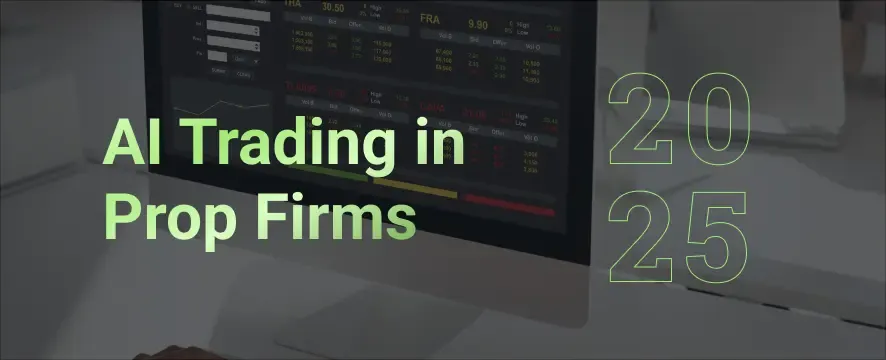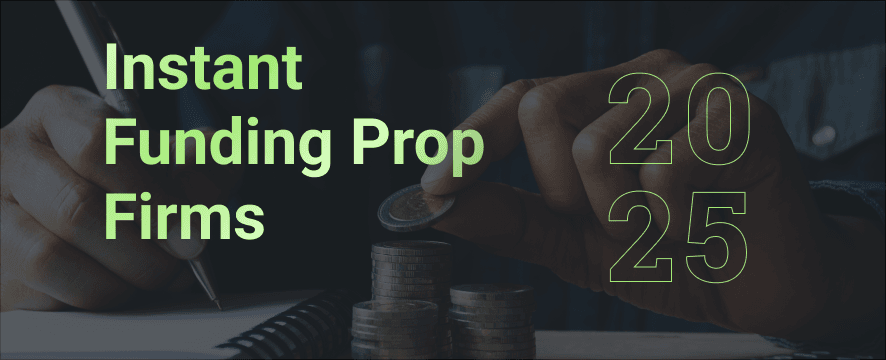
12 min read
Which Prop Firms Allow News Trading? Complete 2025 Guide
Yes, some prop firms allow news trading. This 2025 guide shows which firms permit it, their rules, and how traders can benefit.
18 min read
Share
A funded trading account gives you access to a firm’s capital to trade, share profits, and reduce personal risk.
The financial markets have become a hub for funded trading in recent years. Many traders are discovering new opportunities that were once meant only for large institutions through access to funding being offered by prop firms.
The benefits of funded accounts are clear—access to global markets and the potential to earn returns, while limiting exposure of personal funds. Both aspiring and experienced traders are making full use of this opportunity to test their strategies, sharpen their skills, and earn consistent returns, while prop firms get talented individuals who can generate profits for them.
Funded trading brings down risk, gives discipline its due reward, and fundamentally changes the way traders approach the markets. In this article, we will explore what a funded trading account is and the various application processes and fee structures involved.
Throughout history, investing has meant putting your own money on the line in what is fundamentally a risky proposition. But funded trading is somewhat different.
It is an arrangement where the trader gets access to a proprietary trading firm’s capital so that they can invest in financial markets by employing their own unique strategies (with certain guardrails built in). The profits generated are split between the trader and the firm.
It's worth noting that there is still trading risk and a cost to participate in the various funded challenges.
Here are three reasons why funded accounts are so beneficial to traders:
Firstly, they take away the most crippling disadvantage in trading, namely, a lack of sufficient capital. Traders using a personal account are severely constrained by how much of their own money they can put into trading.
Several strategies that require a temporary but large amount of capital are completely off-limits to such traders. This limits their ability to grow, forces them to choose smaller positions than they would like, and restricts their ability to execute their strategies.
In a personal account, one wrong move or bad trade could mean a financial disaster that ends up ruining your entire future and endangers the happiness of your family and loved ones. When you’re putting your own funds on the line, the stakes are extremely high.
In funded accounts, the majority of the capital risk resides with the trading firm. Of course, since substantial firm capital is involved, there are trading rules and risk management guidelines that must be followed. But funded accounts reduce direct exposure of personal funds, although trading risks remain
Forex traders, futures traders, stock traders, and even crypto traders can get funded accounts. These accounts offer access to several different markets. By spreading capital across different markets, funded traders are able to diversify risk while getting the chance to quickly align their strategies as per the market scenario.
There are three main types of funded accounts, including evaluation–based, instant funding, and hybrid scaling. Choosing the right one usually depends on what level you are at in your trading career. While aspiring traders might prefer evaluation challenge accounts, experienced traders often prefer instant funding accounts. Let’s understand each type.
In this type of account, the trader goes through an evaluation process, which is usually referred to as a “trading challenge.”
The trader is provided with a dummy account with strict risk limits and drawdown limits, and asked to achieve certain profit targets. If they pass the challenge, they unlock substantial trading capital.
In instant funding accounts, there is no evaluation process. The trader has to pay a fairly high upfront cost to access the funding account, but once they do so, they can start trading right away.
This model gives quick access to firm capital, but it also places tighter restrictions on the trader, and the profit shares are relatively smaller. Instant funding accounts are often preferable for experienced traders.
Some funded trading accounts combine the two approaches. Traders can start immediately with a modest initial capital, and as they demonstrate the ability to generate consistent profits, the firm scales the amount of capital available.
Skilled traders interested in acquiring immediate capital but with limited scope to pay the upfront fees often prefer such models over the other two choices.
While the process of how funded trading accounts work varies slightly across different programs, the following outline broadly describes the key stages of the process.
There is a fairly large number of prop trading firms available nowadays. Traders should choose one that provides clear guidelines on its rules, profit-sharing structure, and fees.
Most funded accounts begin with an evaluation process. Traders are allowed to open a "sim account", where they can demonstrate their trading skills in order to achieve the profit targets that have been defined by the firm.
Typically, there are certain drawdown limits and other risk management rules that are applied during the evaluation stage. Prop firms test your ability to generate profits while following disciplined risk management practices.
Once you pass the evaluation stage, you become a funded trader. Now you can place trades using the firm’s capital. The firm shares profits with you as per the agreed-upon arrangement.
Since almost the entire risk in a funded trading account lies with the prop firm, there are strict trading rules that must be followed in all transactions. These rules ensure that traders are consistent, don't go overboard in their strategies, and both the firm and the trader are protected at all times.
Among the most common trading rules to be followed are limits on losses. The 2% rule is almost universally followed: a trader should not risk more than 2% of their account balance in any single trade.
Apart from this, there are daily and overall strict risk limits, also known as maximum drawdown rules. Traders are also required to employ a stop-loss in all trades, so that market volatility does not lead to a major erosion of capital.
These strict risk management protocols prepare the groundwork for building discipline in traders. They help traders sharpen their decision-making processes and weed out bad habits that are inconsistent with professional trading.
This kind of disciplined trading keeps emotions and poor strategies out of the equation, leading to better decision-making. These guardrails form the bedrock of successful funded trading.
The internet economy has led to dramatic changes in the way proprietary trading firms conduct their business.
There was a time when a proprietary trading firm could only have offices in major financial hubs, would only hire traders to work onsite, and would keep most of the profits from the trades conducted.
There was very limited flexibility in trading strategy, and a strict workplace-like culture was followed, keeping the firm's entire business model extremely profitable but limited in scale.
Modern prop trading has changed significantly. Through the use of online platforms, modern prop trading firms have allowed traders to work from their homes, which has allowed them to scale globally.
All that the trader has to do is to prove their skill through some challenges, and once approved, they can start trading independently and with very little interference, right from their own homes. Of course, there is a financial outlay to get started. However, traders no longer need a seat at a Wall Street office to begin their journey.
Another difference is that broker-backed models are slightly more tightly regulated than independent trading firms, while independent firms focus more on flexibility and better profit splits.
Given the proliferation of prop trading firms in recent years, traders interested in a funded trading program have several choices before them when they start their journey.
It is important to understand that the right funded trading program will have realistic expectations from the trader, will be upfront and transparent regarding costs, and will provide them with the tools necessary to grow their trading capabilities.
The most important things to look out for are transparency in evaluation fees, payout schedules, and opportunities for growth.
Make sure that you choose a funded trading program that provides crystal-clear profit-sharing arrangements. It should also have account resets, so that you can easily recover from any mistakes you make on your journey.
Choose a program that lets you access multiple markets, thus giving your trading strategies the scale with which you can deliver better results.
A high-quality funding company will also invest in your capabilities by providing education and platforms that let you grow in your professional trading journey.
Be wary of trading firms that promise unrealistic profit shares or hide fees under the pretext of fine print. There are loads of predatory prop firms that extract inflated entry costs from younger, less experienced traders while not offering any meaningful opportunities to grow.
Also, be wary of funded trading programs whose trading rules are unclear or too strict to remain compliant.
Choosing the right funded trading program is perhaps even more important than choosing the right trading strategy, because at the end of the day, it's very easy to lose a large portion of what you've earned through hidden fees and unnecessarily convoluted rules that only favor the firm.
Profits are, after all, what everyone is working for in the trading world, right? Well, the answer is a partial yes. Funded trading is not just about profits. It is about the ability to generate consistent profits, not just “flash in the pan” results.
Prop trading firms want evidence that their traders can be reliably expected to follow their defined risk limits and rules, which, in turn, ensure that profits are generated on almost every trade, not just once in a blue moon.
This is why many firms have begun to include scaling opportunities in their funding programs. The intent is to reward talented traders who demonstrate the ability to deliver consistent returns.
How this works is simple: you start small, meet your targets, and provide reliable profits. The firm then increases your capital allocation. Over time, skilled traders can grow to manage an increasingly large portfolio without risking personal funds.
Traders have been known to grow to access six-figure accounts purely through their discipline and sheer consistency. Successful traders are also given more flexibility in their strategies.
Like the old adage, trading success breeds more success, because with larger funding and relaxed rules, traders can go on to make bigger trades and earn greater profits.
Now let's get to the part all traders are interested in - the profit-sharing model.
In funded trading accounts, you do not get to keep 100% of the profits you make. Since the firm's capital is on the line, you only get a share of the money.
Most profit-sharing arrangements offer a 70/30 split, but some go as high as 90/10, with the bigger number meant for the trader.
In some cases, firms offer progressive profit splits, which means your percentage goes up as you deliver consistent results over a longer period. This aligns the trader's goals with those of the firm.
For those traders who are able to generate significant profits on a long-term basis, funded trading is a potentially life-changing model. Access to a large amount of capital and a generous profit split make it easy to achieve things that are unimaginable simply from investing your own capital.
Dedicated, hardworking individuals get the means to trade like professionals without having to spend years waiting for their chance.
In order to get access to a funded account, most prop trading firms charge upfront payments known as "evaluation fees." These are meant to filter out frivolous participants who just want to test the waters and leave behind only those traders who are serious about securing long-term opportunities in the field of trading.
Here's what you need to know about evaluation fees.
In most cases, the trader will be charged a one-time fee before they get to access the trading challenge. If they are successful in hitting their targets, they move on to an account where they get to access live capital. In some cases, successful traders even get back the one-time evaluation fees on hitting their targets.
Other firms use a subscription-based model where traders can pay a monthly fee until they qualify. In both cases, you can get access to a funded trading account, securing live capital, by achieving the desired target levels, but the costs can vary significantly.
After the account starts to achieve consistent profitability, the trader might wish to get access to more substantial trading capital. However, this usually requires a bigger entry cost.
A $25,000 account might carry modest evaluation fees, while a $100,000 or $200,000 account usually comes at a much higher cost.
When the firm chooses to assign significant capital to a trader, it reflects greater trust and the firm's willingness to bear higher risk with them.
So we've already looked at most of the parameters needed to understand funded trading, including the evaluation process and various types of entry fees. Now, let's look at a more comprehensive checklist of everything that aspiring traders need to do in order to get a funded account.
Select the right prop firm – As discussed already, traders should prioritize reliable prop trading firms that set realistic goals and transparent fees, and rule structures.
Register and Pay Evaluation Fees – Enroll online in the firm's program, pay the evaluation fees, and complete the other formalities.
Demonstrate Trading Skills – You will be offered a simulated trading account in order to evaluate your capabilities. Make sure you understand the funded trading account securing conditions, such as profit targets and drawdown limits.
Pass the Challenge – Employ your trading genius and achieve the targets through successful trades without breaking any of the rules.
Get Approved – Once the firm gives a final go-ahead, you become a funded trader with access to capital.
Start Trading Live – Start using the firm’s account to trade markets, making sure you follow the proper risk management guidelines as outlined in your agreement.
The steps look fairly easy, but it's important to understand that the key is disciplined trading. Focus on safe trading strategies that follow all the necessary risk control protocols, because if you do not satisfy even one of the conditions of the evaluation, you will not be able to access your funded account.
Approach the simulated trading environment just like you would approach professional trading. Stay patient, keep emotions in check, and respect the rules of the prop firm.
A funded account can be a complete game-changer for your career, giving you access to capital at very little personal risk and a chance to scale big later. With the right mindset, aspiring traders can start trading like professionals within days of joining the program.
SeacrestFunded (formerly MyFundedFX) is a broker-backed prop firm that offers simulated funding from USD 5,000 right up to USD 400,000, with the potential for scaling up the account size, depending on achieving certain criteria.
The firm offers two ways to get into a live sim program: a 1-step model and a 2-step model. You have to choose a challenge size between $5K, $10K, $25K, $50K and $100K. In the 1-step model, the sim gain percentage required to pass is 10%, whereas in the 2-step model it is lower (8% in the first step and 5% in the second). The daily sim loss and overall sim loss targets are also more stringent in the 1–step model.
SeacrestFunded's approach to funded trading is refreshingly transparent and easy for new traders.
It allows various trading styles in the sim phase, including scalping, hedging, swing trading, martingale strategies, grid trading, and more. Secondly, it provides a generous $400,000 in simulated funds, which gives the trader a lot of leeway in setting up multiple trading strategies.
There is a minimum profitable trading day requirement in the 1-step and 2-step models, but there is no such requirement once you get access to a live simulated account. There are 175 markets funded trading accounts from SeacrestFunded get access to, including futures markets, forex trading, index trading, commodities, and even crypto.
The firm has strategic partnerships with Purple Trading, Match Trader, and Quality Fx; so traders get reliable liquidity and access to strong trading platforms like cTrader, Match Trader, and Platform 5.
SeacrestFunded also provides access to a strong community of like-minded professionals through its Discord server, which has over 124,000 members.
Once you pass the evaluation stage, SeacrestFunded grants you an 80% profit split on your net simulated gains, with the option to upgrade to 90% through a paid add-on. You can scale your account to as much as USD 4,000,000.
The firm processes payouts every 14 calendar days for most challenge types, with a minimum payout threshold of about USD 65. On Trustpilot, Seacrest holds a rating of 4.3 out of 5 from thousands of reviews. Traders often highlight its responsive support, fast payouts, and clarity in rules.
More and more traders are choosing funded trading over traditional trading because it allows them to earn profits while avoiding personal financial pressure.
The need for fair and transparent prop trading firms is increasing day by day. SeacrestFunded's clear rules, realistic targets, and competitive payouts make it stand out from the crowd. As funded trading matures, firms like SeacrestFunded are going to win in the long run.
Yes and no. Although you aren't trading using your own capital, there is normally still a cost to participate in the evaluation process, and there is no guarantee you'll pass it. However, if you do pass and become a funded trader, the prop firm takes on the majority of the trading risk while you split the profits according to the agreed-upon arrangement
The main difference lies in the profit targets and difficulty level. In a 1-step model, you need to achieve a higher profit target (typically 10%) in a single evaluation phase, but you get funded faster. The 2-step model breaks it down into two phases with lower targets (like 8% in step one and 5% in step two), making it slightly easier to pass but taking more time. Choose based on your trading style and confidence level.
This depends entirely on your trading performance and the model you choose. There's no fixed timeline - some traders pass their challenges within a few weeks, while others take months. Once you successfully complete the evaluation and get approved by the firm, you can start trading with live capital almost immediately.
If you violate any of the trading rules or exceed the maximum drawdown limit during your evaluation, you'll typically fail the challenge. However, many reputable prop firms offer account resets, which allow you to restart the evaluation by paying a reset fee (usually lower than the original evaluation fee). It's crucial to understand all the rules before you begin trading to avoid unnecessary failures.
Legitimate funded trading accounts absolutely exist, but like any industry, there are also predatory firms out there. The key is doing your homework before signing up. Look for firms with transparent fee structures, clear profit-sharing arrangements, realistic evaluation targets, and positive reviews from actual traders. Red flags include hidden fees, unrealistic profit promises, and overly complicated rules that seem designed to make you fail.

12 min read
Yes, some prop firms allow news trading. This 2025 guide shows which firms permit it, their rules, and how traders can benefit.

10 min read
A funded trader uses a prop firm’s capital instead of their own. Learn how funded accounts work, profit splits, and how to qualify.

13 min read
To become a funded trader in 2025, you must pass prop firm challenges by mastering strategy, risk control, and trading rules.

9 min read
Discover effective AI trading strategies for prop firms to enhance your profits. Learn practical tips to navigate the market successfully. Read more!

8 min read
Instant funding prop firms are becoming increasingly popular, but should you participate?
Get an insight from other users about SeacrestFunded and their experiences. 131K+ members and counting

Get instant access to weekly newsletter.